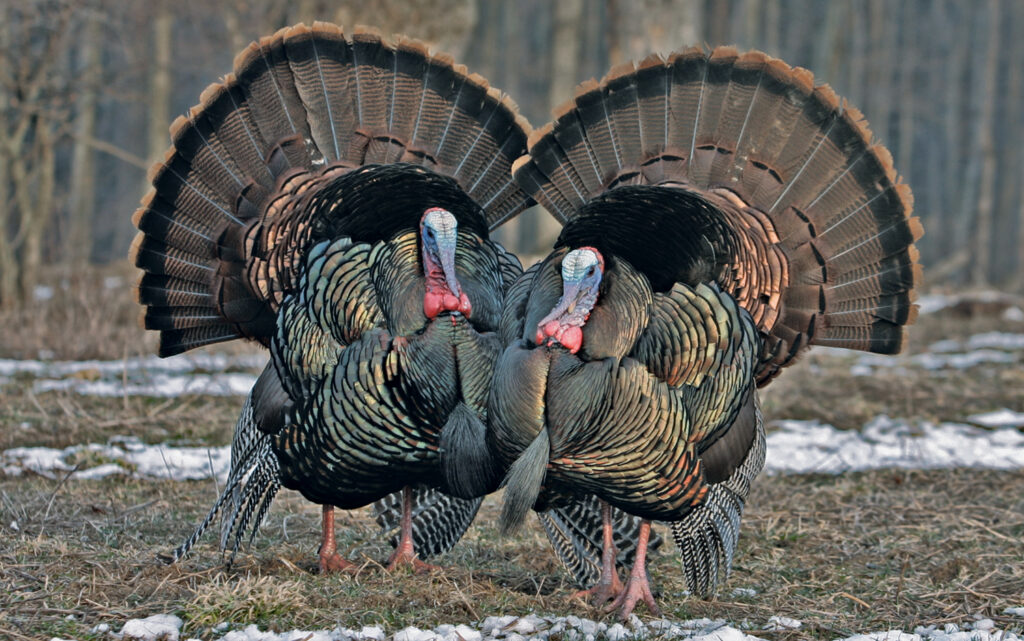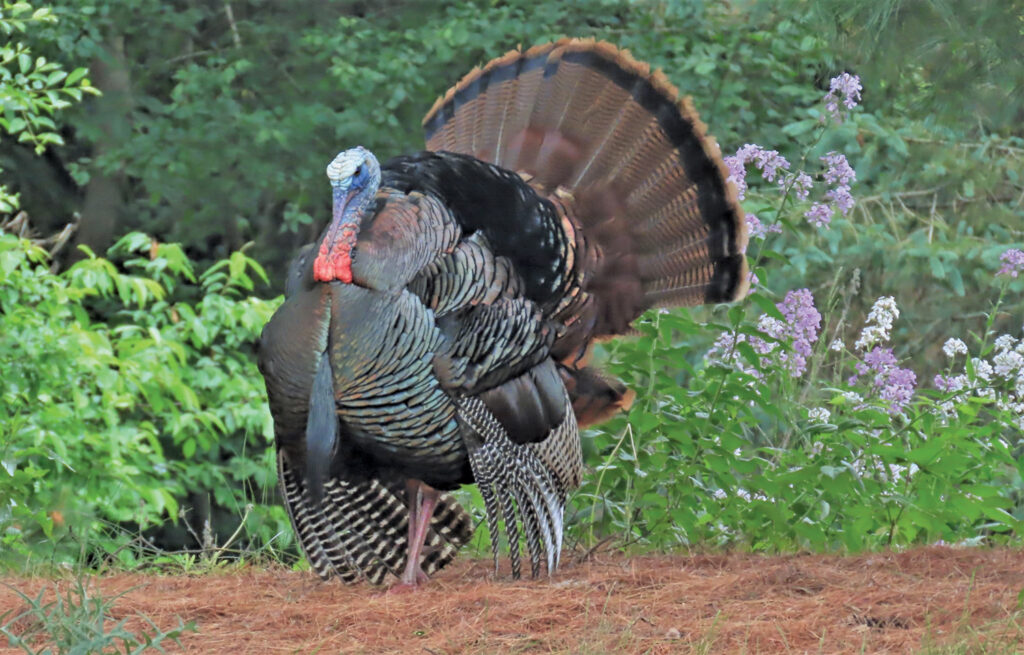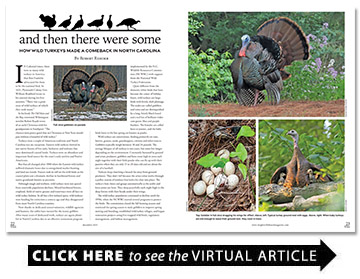And Then There Were Some
How wild turkeys made a comeback in North Carolina
BY Robert Rehder

In Colonial times, there were so many wild turkeys in America that Ben Franklin advocated for them to be the national bird. In 1621, Plymouth Colony Gov. William Bradford wrote in his journal during his first autumn, “There was a great store of wild turkeys of which they took many.”
In his book The Old Man and the Boy, renowned Wilmington novelist Robert Ruark wrote of an early Christmas with his grandparents in Southport: “The chances were pretty good that no Christmas or New Years would pass without a houseful of wild turkey.”
Turkeys were a staple of American tradition and North Carolina was no exception. Eastern wild turkeys thrived in our native forests of live oaks, hickories and walnuts that once dominated coastal lands. Turkeys were an abundant and important food source for the state’s early settlers and Native Americans.
But that all changed after 1900 when the Eastern wild turkey suffered dramatic losses due to unregulated market hunting and land use trends. Nature took its toll on the wild birds as the coastal plain saw a dramatic decline in hardwood forests and native grasslands known as pocosins.
Although tough and resilient, wild turkeys were not spared from statewide population declines. Mixed hardwood forests, cropland, fields of native grasses and waterways were all keys to wild turkey habitat. In all but a few isolated spots, wild turkeys were heading for extinction a century ago and they disappeared from most North Carolina counties.



Now thanks to dedicated conservationists, wildlife agencies and hunters, the tables have turned for the iconic gobbler. After many years of dedicated work, turkeys are again plentiful in North Carolina due to an effective restoration program implemented by the N.C. Wildlife Resources Commission (NCWRC) with support from the National Wild Turkey Federation.
Quite different from the domestic white birds that have become the center of holiday feasts, wild turkeys are large birds with lovely, dark plumage. The males are called gobblers and toms and are distinguished by a long, bristly black beard and a tail fan of brilliant iridescent green, blue and purple feathers. The females are called hens or jennies, and the baby birds born in the late spring are known as poults.
Wild turkeys are omnivorous, feeding primarily on nuts, berries, grasses, seeds, grasshoppers, crickets and other insects. Gobblers typically weigh between 18 and 24 pounds. The average lifespan of all turkeys is two years, but some live longer depending on the environment. Constantly harassed by ground and avian predators, gobblers and hens roost high in trees each night together with their little poults who can fly up with their parents when they are only 15 to 20 days old and are about the size of a baseball.
Turkeys sleep clutching a branch far away from ground predators. They don’t fall because the avian talon works through a pulley system of tendons that locks the claw into place. The turkey’s foot closes and grasps automatically as the ankle and knee joints are bent. They sleep peacefully each night high in the deep forests with their heads under their wings.
The wild turkey population continued to decline until the 1950s, when the NCWRC started several programs to protect the birds. The commission closed the fall hunting season and restricted the spring season to male gobblers to improve spring nesting and breeding, established wild turkey refuges, and began restoration projects using live-trapped wild birds, regulatory management, and habitat management.
The restoration program involved live-trapping and relocating wild turkeys from sites in North Carolina and other states to areas in the state where turkeys had previously disappeared. Selection of wild turkey restoration areas involved identifying the areas with the best habitat.



All restoration activities were coordinated through the NCWRC Wild Turkey Project. Requests for restocking sometimes came from reciprocating agencies, clubs and individuals. The first contact in a site selection was usually with a NCWRC district biologist or other personnel who were familiar with the area.
One of those biologists was Vic French, who worked primarily in Southeastern North Carolina.
“Each year, most of the trapping efforts were made after the deer season closed in January just prior to the wild turkey breeding season,” French says. “In these winter releases, usually 15 to 20 wild turkeys were released on each restoration area. If the stocking took two years to complete, sometimes as many as 20 would be released.”
One of those areas was the Charles Godwin family property off Shaw Highway in Pender County, bordered by Ashes Creek and the Holly Shelter Game Land. Godwin was the chairman of the National Wild Turkey Federation chapter in Pender County and was active in the relocation project on his land.
At the time of the turkey restoration, the Godwin farm was about 1,200 acres. It was an ideal place for wild turkey management as it had open fields of native grasses, croplands, a waterway, plentiful hardwoods, and a peaceful, undisturbed rural setting.
“We used a ratio of two to three hens per gobbler with a minimum of 10 hens and five gobblers,” French says. “There were several mature gobblers mixed with 1-year-old-birds called jakes. We used birds from different sources to ensure genetic variability at each restoration area. We always tried to release one to two adult males and up to five adult females to ensure breeding would occur the first spring.”
The program used a trap-and-transfer project to restore wild turkeys where the birds had previously disappeared. NCWRC staff used rocket nets — an animal trap used to catch many live birds at once without harming them. The Ashes Creek project was one of the most successful of many relocation sites.
“The earliest techniques used a 40-by-60-foot, 2-inch mesh net propelled by three projectile cannons placed inside a cylinder fired by black powder and ignited by a blasting cap similar to a black powder rifle,” Godwin says. “But at our farm and other capture sites the commission used an improved, faster rocket net system, known as the Miller Cannon, that used rockets attached to net leads and propelled by commercial powder charges fired by a hand-operated detonator. This system travels at 400 feet per second, about as fast as a 38-caliber bullet, and the net is over the birds before they can run or fly.”



To find a suitable population of wild birds to be trapped, wildlife officers, biologists and technicians had to meticulously scout to locate a flock’s feeding patterns and then sometimes wait for hours in rough weather for the birds to come in range of the nets. After the net was shot, the birds were gently removed and placed in special boxes to be taken to the release sites. The captured birds were banded with a numbered leg band for further research.
When the state’s trap-and-transfer program ended in 2005, wildlife biologists had relocated more than 6,000 wild turkeys to 358 restoration sites. About 1,800 of those birds were acquired from other states through the National Wild Turkey Federation Super Fund Program.
“Restoring wild turkeys to North Carolina took many decades of hard work and commitment. Changing our hunting regulations and a successful trap-and-transfer program were key pieces of restoration,” says Chris Kreh, assistant chief and program coordinator of the NCWRC Game and Furbearer Program. “But North Carolina didn’t do it alone. We had tremendous help from the National Wild Turkey Federation, which allowed us to receive wild turkeys from other states and release them in areas of good habitat here in North Carolina.”
The program was a massive success and now the wild turkey is one of the most popular game animals in the state.
“The descendants of those original turkeys thrive on our farm today,” says Godwin. “We work with the commission to provide food plots, land management, and periodic burning to support turkeys. We have several flocks, and they are the healthiest, smartest, most difficult birds that you will ever try to hunt.”
Challenges remain in maintaining and managing wild turkey populations in North Carolina, but for now they are a beloved and frequently observed species that exist in all 100 counties. The latest figures show an increase from an estimated population of 2,000 birds in 1970 to about 270,000 birds in 2023. North Carolina showed the highest ever recorded hunter harvest of 24,089 birds in the spring of 2023.
Once again, these beautiful, wild birds thrive in our North Carolina forests and fields — an iconic symbol of America’s wildlife heritage.
